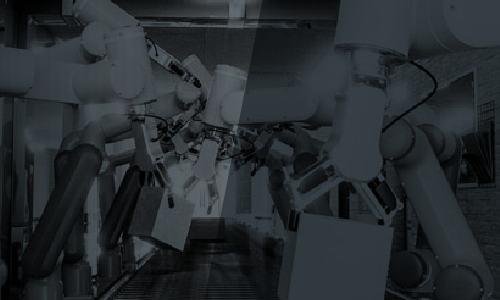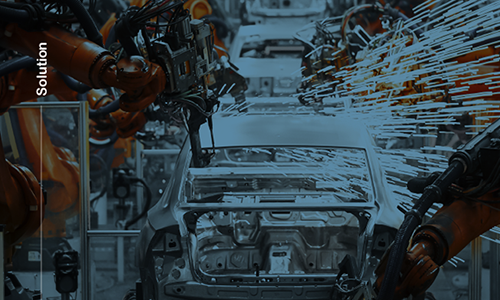Common Issues in Automotive Manufacturing?
Application Field|Automotive ManufacturingThe quality of stamping in automotive manufacturing directly affects production costs, and the condition of robotic arms can have various impacts on the production line.
Execution Motivation
Common Issues in Automotive Manufacturing?
Understanding Issues in Automotive Manufacturing
The production process of automotive manufacturing is generally divided into: Stamping → Welding → Painting → Final Assembly.
All vehicles are formed by pressing steel sheets using metal stamping technology, followed by welding assembly, painting, and final assembly of internal components.
Common issues in the manufacturing process include inconsistent stamping quality, welding defects such as missed welds or inaccurate welding, difficulty in monitoring the operation of numerous industrial robots, uneven painting quality, equipment quality in final assembly, and the operational quality of large handling arms.
The automotive manufacturing process relies heavily on industrial robots, mechanical arms, and stamping equipment.
Proactively Managing Automotive Manufacturing Equipment to Increase Reliability
Various equipment used in automotive manufacturing, if not maintained in time due to aging, may lead to reduced production efficiency, delayed delivery, large amounts of defective products, and even unnecessary workplace safety risks.
The automotive manufacturing process utilizes a large number of precise automated machines, making each step highly complex and intricate.
Ensuring quality at every stage of the process helps prevent unnecessary waste.
With the rise of smart manufacturing and a saturated automotive market, many manufacturers are offering customized services to enhance vehicle intelligence and quality.
Collecting large amounts of usable data in equipment management can significantly improve the design of production processes.
Early implementation of equipment monitoring can ensure stability and extend equipment lifespan.
How to Execute
How to Diagnose and Manage Automotive Manufacturing Equipment?
Various equipment used in automotive manufacturing, if not maintained in time due to aging, may lead to reduced production efficiency, delayed delivery, large amounts of defective products, and even unnecessary workplace safety risks.
Automotive Welding Process
Welding is an essential part of automotive manufacturing, and there are many welding methods, including spot welding, arc welding, stud welding, gas welding, and projection welding.
Automotive Stamping Process
Stamping technology significantly affects automotive manufacturing quality and production costs. Inspecting the quality of stamped parts ensures precision throughout the stamping process.
Execution Challenges
How to Diagnose and Monitor the Automotive Welding Process?
Spot Welding, Arc Welding, and Other Welding Robotic Arms
Welding is a crucial process in automotive manufacturing. It mainly involves numerous welding robotic arms and automated production line equipment to assemble stamped vehicle bodies and components.
There are various welding methods, such as spot welding, arc welding, stud welding, gas welding, and projection welding.

Since welding quality is vital in automotive manufacturing, the process is now mostly automated. The accuracy of welding robotic arms significantly affects the vehicle body. If welding is excessive or insufficient, it may lead to defects in body quality.
Execution Goals
Establishing a Standardized Model to Replace Human Experience
# Establishing Standardized Guidelines to Ensure Welding Quality
In automotive manufacturing, robotic welding arms play a key role in production accuracy and product yield.
By setting threshold values and monitoring movement accuracy during manufacturing, welding consistency and standardization can be ensured.
# Collecting Useful Data to Optimize Manufacturing Processes
As robotic arms replace human labor in complex or precise movements, incorporating object variability and quantitative data is essential.
By integrating human expertise with real-time monitoring of machine vibrations and current fluctuations, manufacturers can optimize production efficiency.

Production Line Standardization

Welding Quality Standardization

Data Collection

Process Optimization
How to Execute
The Role of Welding Robotic Arms in Automotive Manufacturing
Welding robotic arms enhance production efficiency by executing precise and hazardous tasks, reducing human workload. Every motion in this process affects product quality.
Real-Time Detection of Robotic Arm Motion Signals
GoodTech's VMS-ML robotic monitoring system detects real-time motion or current signals of robotic arms. Even minor anomalies can indicate potential failures or welding defects, allowing operators to take preventive measures. This ensures uninterrupted production and prevents unexpected failures from disrupting manufacturing operations.
VMS-ML Robotic Monitoring System
Execution Challenges
How to Monitor and Diagnose the Automotive Stamping Process?
Measuring Die Variations and Stamping Machines
Around 60-70% of automotive parts are produced through stamping, making stamping technology crucial for both manufacturing quality and production costs.
When inspecting stamped parts, it is essential to ensure that no unnecessary dents or marks are formed during the stamping process.
By measuring die variations and monitoring stamping machines, users can instantly assess production line quality, intercept defective products early, and maintain dies before they deteriorate to prevent damage.

Execution Goals
Monitoring the Stamping Process
# Early Detection of Defective Products to Reduce Costs
The stamping process demands precision, speed, and high repeatability.
In a fast-paced automated production line, small defects in dies can gradually escalate into major issues.
Without timely intervention, large numbers of defective products may be produced, leading to increased costs.
Identifying defects early helps intercept defective parts before they impact production, prevents rapid die deterioration, and minimizes cost wastage.
# Monitoring Stamping Machines to Ensure Equipment Reliability
Maintaining the quality of stamping machines is essential for cost reduction, increased production efficiency, and lower defect rates.
While wear and tear on machines is inevitable, monitoring every component and planning maintenance based on measurement data helps keep equipment in optimal condition and minimizes defect rates caused by machine failure.

Early Defect Detection

Cost Reduction

Machine and Process Monitoring

Reducing Defect Rates
How to Execute
Monitoring Stamping Machines in Automotive Manufacturing
Stamping machines in automotive manufacturing come in various models, with different processes and speeds depending on the type of parts produced. Additionally, the speed range may vary each time the machine is powered on or off, requiring an automated adjustment system for effective monitoring.
GoodTech's VMS-ML machine learning intelligent monitoring system features automated AI learning capabilities. It helps users quickly establish signal characteristic models, enabling more precise anomaly detection and early defect prevention.
VMS-ML Machine Learning Monitoring System






